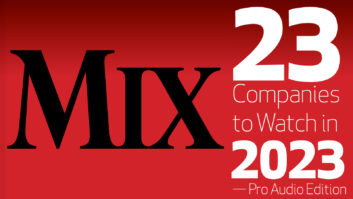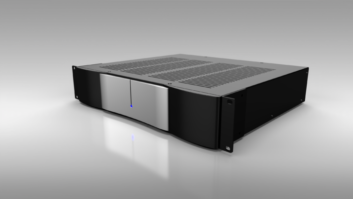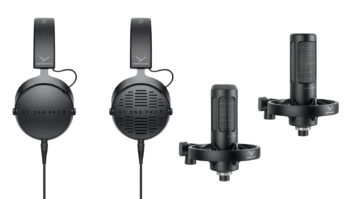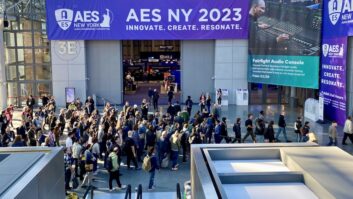Groove Collective with Bernie Worrell at Le Poisson Rouge
by Clive Young.

New York–The devastating earthquake that hit Haiti in mid-January has inspired many musical efforts to raise money for relief. While high-profile events like the widely viewed Hope For Haiti Now TV special and various charity singles have captured international attention, regional benefit concerts across America have also taken place, with venues, SR providers and live sound engineers all collaborating to make a difference. In many of these cases, modern pro audio technology has helped local-level relief events achieve greater effectiveness.
Just days after the earthquake, New York City’s Highline Ballroom hosted For The People, a benefit featuring underground hip-hop acts, including rising Canadian rapper Eternia. “I think everyone wanted to do something to aid the situation in Haiti once we all found out what had happened,” she said. “It’s a blessing to be able to support and give aid with the talents God blessed us with, plus we got to reconnect with good folk, and be moved by the other performers on stage–I was humbled and grateful to be involved.”
In all, 11 acts took the stage, and while cramming that many performers into one show might normally make for a rough evening on the crew, Peter Auslan, the Highline’s production manager, found that audio technology had a positive impact on the event.
“If benefit shows are easier to do, people are more likely to do them,” Auslan opined. “When someone says, ‘Let’s put this show on, and we have five days to get it together,’ people now feel more comfortable trying to make that challenge become a reality, because the tools are out there that let you do it. The technology has gotten so much better that we can accommodate these events and make them run on schedule.”
The Highline sports a JBL VerTec PA and VRX 900 series monitors that are fed sound from Yamaha PM5D-RH and M7CL-48 consoles at the respective house and monitor mix positions. The desks, said Auslan, made a difference: “Imagine doing nine bands on one analog desk–charting it for every single act and then trying to recall it based on your chart, sometimes in the dark. There’ll always be someone who decided to turn his guitar up or down. But, digital consoles are generally not going to be a problem. The thing they excel at most is being able to accommodate large volumes of acts quickly–the changeovers and transitions are a lot easier, and they really helped that night.”
Of course, technology will only get you so far if there’s no cooperative spirit, but fortunately the event had plenty of both. “People were willing to compromise because they knew time was of the essence,” said Auslan. “We made a basic festival input list that was a catch-all–lots of vocal mics at every conceivable position, so no matter where you were on stage, you could grab one if you felt you needed to say something. The drum kit didn’t move, and we weren’t dealing with multiple keyboard rigs and lots of Pro Tools; we’ve had to put together things that were way more complicated in less time, but in this particular case, we were lucky.”
Pro audio technology can do far more than just bring music to a crowd; for instance, it expanded the audience of a James Taylor benefit concert held at the 680-seat Mahaiwe Theatre in Great Barrington, MA on January 22. The show sold out in 90 minutes, prompting a second night to be added. Between both concerts, sales raised more than $480,000, including a match of $155,000 by Taylor. Inspired to push further, the singer collaborated with Albany, NY-based WAMC Northeast Public Radio to broadcast the first show live, generating another $80,000 across seven states.
All proceeds went to Partners in Health. “They are the largest health care provider in Haiti, so they were uniquely placed to help with emergency medical response,” said Bruce Clapper, a house engineer at the Mahaiwe. The event found Clapper manning a Yamaha M7CL-32 desk at the FOH position, sending audio to the venue’s Crown-powered PA based around a JBL VerTec line-array cluster and various SRX715s. Monitors were sent back to the stage from the house desk, leading to four mixes on Audio-Technica personal monitor systems, and three wedges.
WAMC became involved in the project only seven days before the Friday night broadcast, and while the initial plan was to air a live FOH board feed with room mics blended in for ambiance, more gear was brought to bear on the process. During the event, WAMC house engineer Adam Clairmont found himself beneath the stage in a greenroom crossway, mixing the show on a Yamaha 02R console while hearing the results through Behringer B2031 studio monitors. Tied into the internet via a DSL connection, the mix was sent to WAMC’s studios for broadcast via internet streaming technology from Tieline.
“The night before, I heard they wanted to multitrack,” said Clairmont, “so I sent everything pre-fader via Lightpipe to a Mackie MDR24/96 hard-disk recorder. I recorded 14 tracks, plus my stereo mix was recorded as well, and I also went 2-track to a DAT machine in case the multitrack went down. Friday night was the broadcast, and I was asked if I could come back on Saturday because they’d have video cameras rolling and wanted audio. There wasn’t a hard-set plan, but the idea was that maybe some magic would happen and they could create a download to raise a little more funds for Haiti.”
While Taylor’s high profile helped supercharge his event’s grosses, Clapper saw the concerts as part of a larger trend: “This sort of show is happening all over the country. I see on Facebook that some musician friends are having special nights or donating the gate from events they’re doing. The word gets out; just advertising to sell tickets is a lot less work nowadays [due to the web].”
Internet publicity fueled some of the success of a recent charity concert at The New Deltona Library Amphitheatre in Florida, assembled by the City of Deltona in collaboration with songwriter/activist Lloyd Marcus. “Our company got involved in the concert through him,” said Frank Starchak of Deltona-based audio provider Star Sound Productions. “It was wonderful to see so many local and regional artists get involved and donate their time, proving that musicians can come together and show their love in times of need.” Fielding a Mackie 40-8 console and a mix of Yamaha and JBL loudspeakers for the house audio, Star Sound backed acts such as G Force, Then 2 Now, Jen Stackpole, Adrian Sutton, Bill Scott, Little Lissy and The Frankie V Orchestra.
The power of the web has been harnessed in other ways, too, for relief concerts. Brice Rosenbloom, a booker at Le Poisson Rouge (LPR), an Avant Garde club in New York City’s Greenwich Village, has been using viral videos from LPR’s own benefit show to raise money. LPR’s concert, held January 19, featured Roy Hargrove, Groove Collective, DJ Logic, Bernie Worrell and Dr. Lonnie Smith, among others; highlights are available online at haitirelieflive.com.
Richie Clarke, the venue’s technical director and chief sound engineer, explained, “Brice set up the site, where video and streamed material from various charity events for Haiti are put together so that people after the fact can view them and make a donation. It’s a great way to make these concerts not just a one-day tool to benefit Haiti, but an ongoing tool–they have a reach beyond merely the days that the concerts were held. Everyone wants to help, but in these times, many feel that they don’t have a lot of power to make a difference. I think knowing that every little bit can help and that other people are adding their bit encourages people to give more than in other situations.”
Clips from the LPR benefit were created through the venue’s Walters-Storyk Design Group-created audio system, consisting of a Digidesign Venue Profile console for house, another Yamaha M7CL for monitors, a Meyer Sound M’elodie PA and L-Acoustics wedges on stage. The venue typically offers DVD and CD recording for performers, taking advantage of its Pro Tools rig, as well as a stationary camera placed at the raised FOH position; that system was employed to create the video clips, and of course, fees were waived in light of the charity cause.
It may well be that there are more events going on for Haiti relief than some catastrophes in the past (for instance, Clapper will mix another charity event at the Colonial Theatre in Pittsfield, MA on Valentine’s Day), or it may be that awareness of these benefit shows has been raised by tools such as the internet. Regardless, technology is being use to help make a difference, and in turn, that opportunity is changing the people who use the technology. The Highline Ballroom’s Auslan explained, “What’s great about these kinds of shows is people realize it’s not about them but about helping other people in real need, and almost everybody universally agrees that music is a great way for people to come together. For our show, the performers were accommodating, and the crew showed adaptability. Everyone felt, ‘Whatever it takes, let’s make this happen.'”
Partners in Health
www.pih.org
Haiti Relief Live
www.haitirelieflive.com
Highline Ballroom
www.highlineballroom.com
Le Poisson Rouge
www.lepoissonrouge.com






